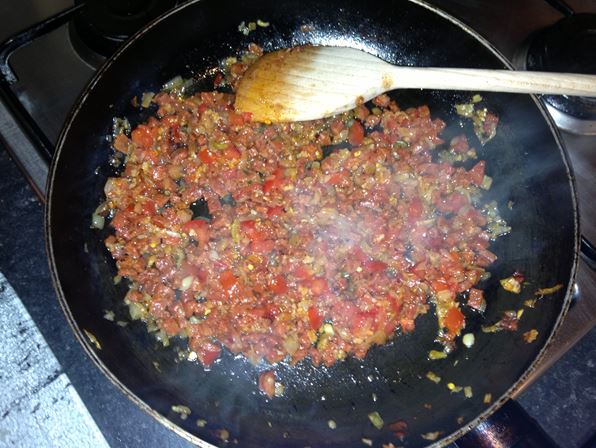I cooked dinner on Thursday evening for my mum, grandma and Linda (mother to one of my best friends, she's a family member without the DNA ties!). My mum had been telling both of them about Printed On A Chutney Jar and my cooking progress so they were both keen for a demonstration. Having gone to bed at my Aunty Caroline's house the previous night reading Rick Stein's 'Spain', it seemed appropriate to give a couple of recipes from this fantastic cook book a go, neither of which I'd cooked before.
Dinner was supposed to be served at 8pm but ended up being served shortly after 9pm, who knew that all that fine chopping would take such a long time! Lots of prep work for these dishes but the recipes themselves weren't difficult and the end result looked a lot more impressive than it actually was!
So here they are: Andalucian Shrimp and Spring Onion Fritters and Baked Scallops with Guindilla Pepper, Chorizo and Crisp Breadcrumbs. I served the two starter dished together with a simple green salad with a scattering of fresh from the freezer frozen peas. Delish!
Andalucian Shrimp and Spring Onion Fritters (makes 16 fritters)
Rick Stein's recipe uses raw peeled prawns and he talks you through the process of dealing with them. I however used frozen cooked prawns, just allowing time for them to thoroughly defrost before preparing this dish. I also used twice the amount of spring onions (he said 2, I used 4 for some unknown reason - I didn't realise until afterwards!)
Ingredients
300g small cooked prawns
175g plain flour
½ tsp baking powder
1 tbsp dry white wine
4 spring onions, thinly sliced
1 tbsp chopped flat-leaf parsley
Olive oil, for shallow frying
Salt
Method
Sift the flour, baking powder and a pinch of salt into a mixing bowl. Make a well in the centre and add 300ml water and the wine. Gradually mix the dry ingredients into the liquid to make a batter, then whisk until you have a thick cream. If the prawns have been defrosted, make sure the excess water has been removed with kitchen paper. Fold the prawns, spring onions and parsley into the batter.
 |
| The batter mixture |
Pour 5cm of oil into a large frying pan and place over a high heat. Leave until hot but not smoking, and until a drop of the batter into the pan and spread each one out a little with the back of the spoon so they develop lovely think, crispy edges as they cook. Don't be tempted to overcrowd the pan - I managed to cook 3 at a time.
Cook, turning the fritters over every now and then, for about 2 minutes or until puffed up and golden brown on both sides. Remove with a slotted spoon and drain on a tray lined with plenty of kitchen paper. Eat straight away while they are still hot and crisp.
Baked Scallops with Guindilla Pepper, Chorizo and Crisp Breadcrumbs
(serves 4 as a starter)
Ingredients
5 dried guindilla peppers or ½ tsp crushed dried chilli flakes (I went with the flakes as I happened to have some in the cupboard)
4 tbsp olive oil
75g finely chopped shallots
4 large garlic cloves, finely chopped
65g cooking chorizo sausage, skinned and finely chopped (I didn't bother skinning mine!)
1 roasted red pepper, finely chopped (this was job number one and it roasted whilst I chopped everything else!)
2 vine-ripened tomatoes, skinned, seeded and chopped (again, no skinning, no de-seeding!)
8 prepared large scallops (ideally served in the shell with the coral attached, mine unfortunately were not - sad face) Mine were actually smaller scallops so it was 4 per person
80g breadcrumbs, made from crustless day old white bread
Sea salt
 |
| Lots of fine chopping!! |
Method
If you're using the proper dried guindilla peppers, remove the stalks, slit them open and remove all the seeds. Soak in hot water for 1 hour. Drain the peppers and scrape the flesh away from the skins with a spoon. Discard the skins.
Preheat the oven to 200°C/Gas Mark 6. Heat 3 tablespoons of olive oil in a frying pan over a medium heat. Add the shallots, garlic and chorizo and cook gently, stirring occasionally for 5 minutes or until the shallots are soft and sweet. Add the guindilla pepper flesh (or in my case the chilli flakes), roasted red pepper and tomatoes, season to taste with a little salt and simmer for another 3 minutes.
Detach the scallops from their shells and cut them horizontally in half, leaving the coral attached to one slice. Spoon some of the sauce into the bottom of the shells (or into beautiful terracotta dishes like me!). Season the scallop pieces lightly and place a row of scallops across the dish on top of the sauce.
 |
| The dish in stages before it went into the oven |
Mix the breadcrumbs with the remaining olive oil and a pinch of salt and sprinkle over the scallops and partly over the sauce. Place them side by side on a baking tray and bake on the top shelf of the oven for 8-9 minutes or until the scallops are just cooked through and the breadcrumbs are crisp and golden.
A very scrummy Spanish supper!
 |
| Dinner is served! |
Please note all photographs used in this blog entry are actual pictures of my cooking, not file photos.



























